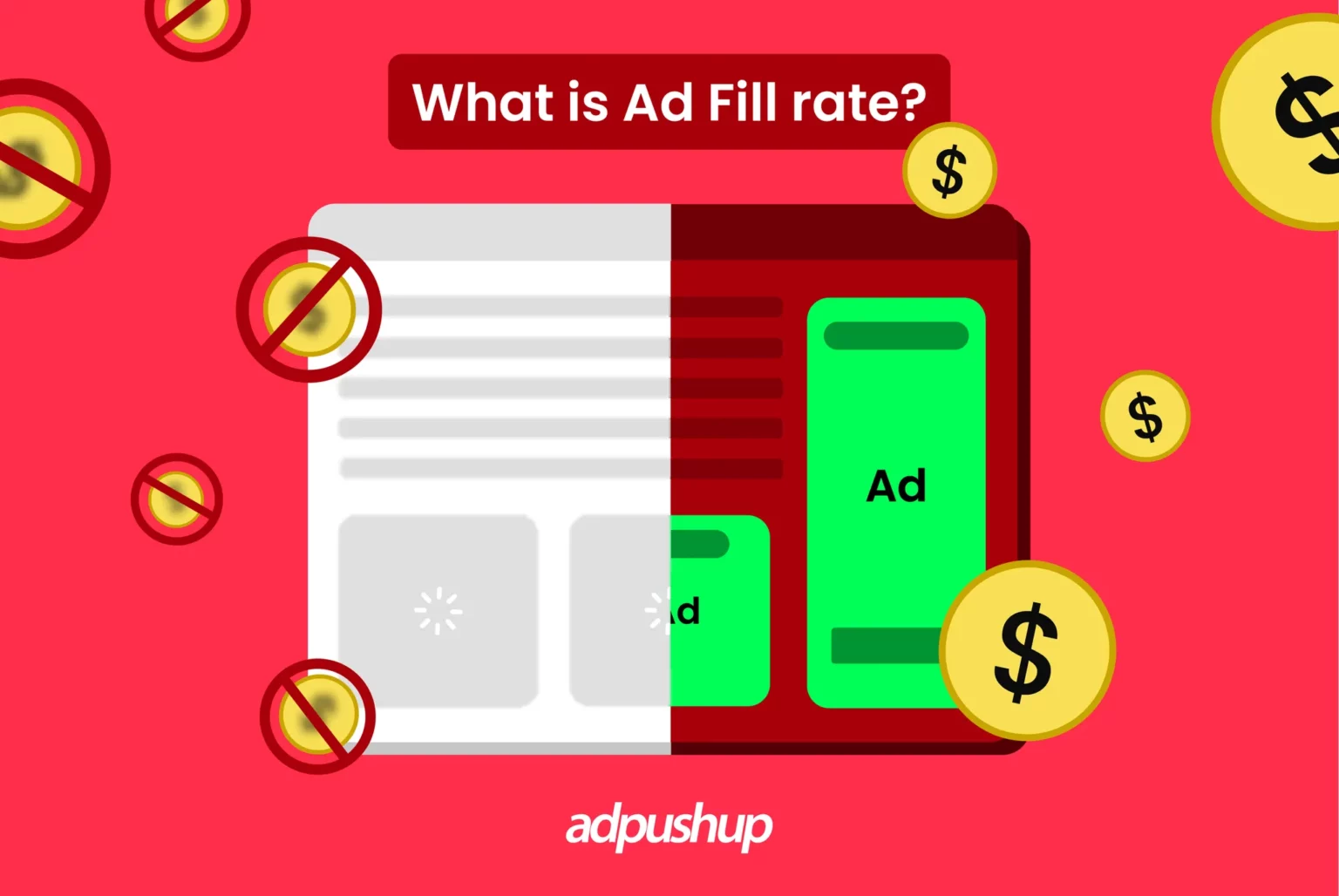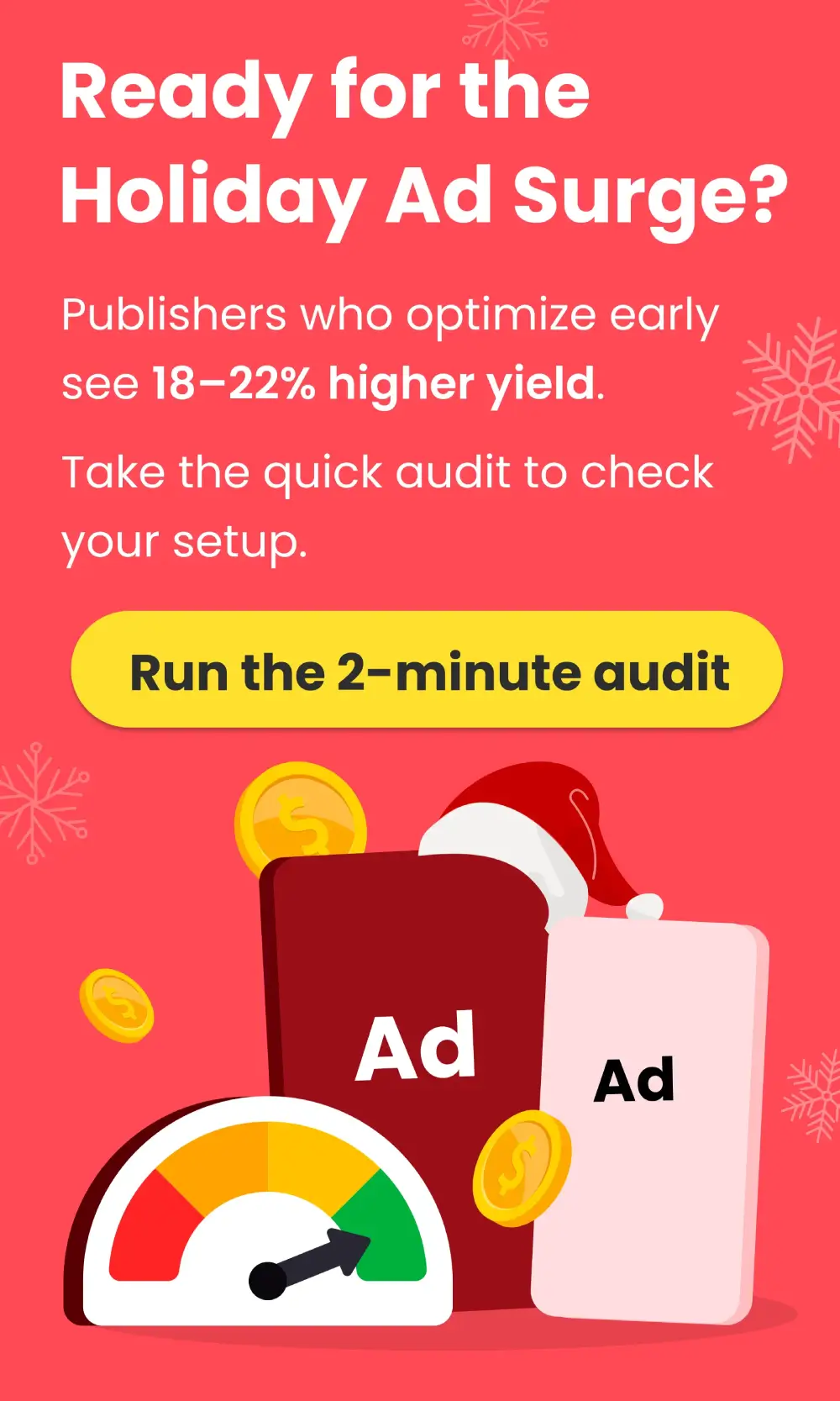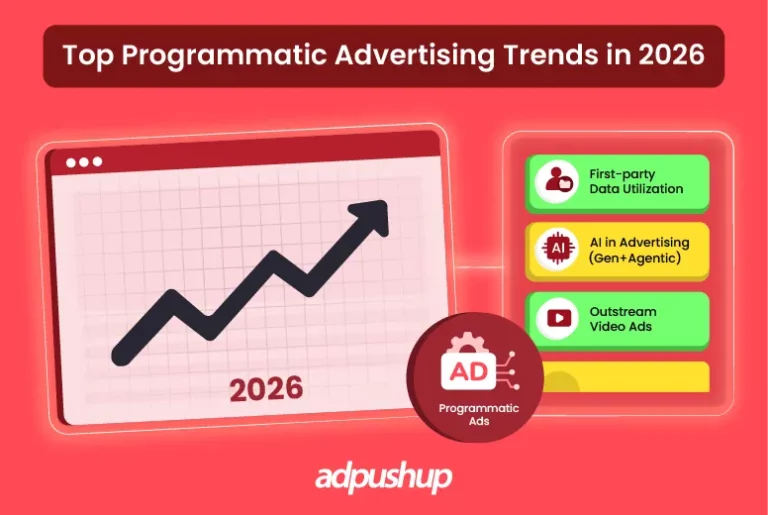Ad fill rate is the percentage of ads served to the user against the number of ad calls made to the website. Read our blog to know what factors can affect your ad fill rate and how you can overcome them.
Most publishers rely on advertising as a primary source of revenue. However, the growing competition for ad dollars has made it challenging for publishers to generate profits.
In light of this, publishers have had to explore a number of alternative methods of revenue generation, such as –
- Charging for access to premium content.
- Incorporating alternative advertising strategies.
- Crowd-funding to raise money from fans or supporters.
In fact, according to a study by Siteefy,175 new websites are created every minute, making the competition more fierce.
In this competitive landscape, ad fill rate is a crucial metric that measures the percentage of ad impressions that are successfully delivered to a website or app.
By closely monitoring their ad fill rate, publishers can make informed decisions to optimize their advertising opportunities and increase their ad revenue.
Let’s take a closer look at what the ad fill rate is and how to calculate it. But first, let’s understand what ad fill rate means.
What Is Ad Fill Rate? (Ad Fill Rate Definition)
Ad fill rate or programmatic fill rate is a metric, which is used to measure the percentage of an ad impression successfully served to a website or an app.
Technically speaking, programmatic fill rate is the percentage of ads’ getting served’ out of the total number of ad calls being requested on a site/page.
Your ad fill rate helps you decipher the proficiency of your ad network. A high programmatic fill rate signals a strong, effective ad network, while a low rate could indicate underperformance.
Let’s understand the same more simply.
High ad fill rate – A high ad fill rate means that a large percentage of ad requests are being fulfilled with advertisements.
Low Ad Fill Rate – A low ad fill rate means that only a small percentage of ad requests are being fulfilled with advertisements.
How To Calculate Ad Fill Rate?
Let’s do some math:
For instance, your apartment has space for 20 tenants. Out of 20, only 17 tenants are residing in and paying you the rent. Now, here the catch is: we’re not counting the number of ad spaces you sold.
For the reason that you managed only 17 paying tenants in a space of 20, your fill rate (17 divided by 20 times 100) amounts to 85%.
Likewise, let’s say your website abcdef.com has the bandwidth to serve 2,00,000 impressions but ends up serving 1,75,000 impressions. So, by applying the same formula as above, your ad fill rate will be 87.5%.
→ # of ads delivered ÷ # of ad calls made x 100 = Ad fill %
In case you get 1,85,000 impressions the next day, your programmatic fill rate will rise from 87.5% to 92.5%. (which may or may not be good news. We’ll tell you why)
Why Am I Not Getting 100% Ad Fill Rate?
There are several reasons as to why your ad fill rate is not 100%, such as:
Technical Errors
The entire programmatic advertising ecosystem is intertwined. Multiple facets work together to keep the ad space buying/selling cycle going. When an ad is shown to a user, thousands of processes would take place, that too within milliseconds.
These overlapping systems and a multitude of technicalities tend to create room for errors, hence affecting your fill rate. To mitigate this, it is better to have a full-fledged AdOps team or an ad partner to reduce such errors.
Page Latency
Yes, page latency can affect the ad fill rate. If the page takes too long to load, the ad server may not be able to fill the ad space in time, resulting in the ad not being shown.
This can result in a lower ad fill rate and decreased revenue for the publisher.
It’s important to monitor and optimize the page loading speed to ensure that the ad space is filled and maximum revenue is generated.
Compatibility
Ads may not always display consistently across all browsers, devices, or operating systems due to compatibility issues. Generally, this happens due to outdated browsers or outdated operating systems that need to be updated.
Moreover, you need to make sure that ads run properly on mobile devices. It’s because an increasing number of advertisers are targeting people with mobile ads. Using the right ad format will ensure that your ads display correctly on various devices and increase the chances of reaching your target audience.
This will help to improve your ad’s fill rate and ultimately enhance your overall advertising performance.
Ad Blockers
Ad Blockers can eat up a major chunk of your ad revenue. What makes the matter worse is that these ad blockers now have started blocking the ad networks themselves rather than ad calls. Due to this, the ad request may go through, but the ad never renders.
However, you can recover your lost ad revenue with Adrecover’s AdBlock Bypass Solution.
Unoptimized Floor Price
Another reason for the low fill rate is poorly optimized floor prices. Very high floor prices will attract only a few advertisers who can pay that much. However, having very low floor prices can also be detrimental as those prices may not justify the value of your inventory.
Hence, it’s advisable to analyze the trends to determine the ideal floor price for your ad inventory.
Seasonal Demand Fluctuations
Seasonal demand fluctuations are also one of the reasons for the low ad-fill rate. During peak season, such as the holiday season or festive sales, there is a spike in user and advertiser activities. This leads to more demand for ad inventory and, hence high fill rate.
However, there is a sharp drop in advertiser activity during the lean season (low-demand period) as they decrease their advertising budget. This leads to surplus supply but less demand, leading to a low fill rate.
Invalid Traffic or Fraud Concerns
Having low-quality or invalid traffic (IVT) is also considered to be one of the top reasons for low fill rate. When a website’s certain portion of traffic is bot or invalid, this raises fraud concerns among the advertisers. Due to this, many ad networks may avoid rendering your ad request or even blacklist the website altogether.
To overcome such situations, look for unusual spikes in your traffic graph. And accordingly, optimize your traffic sources. You can also use IVT detection tools like DoubleVerify or Moat to identify and block bot traffic.
Poorly Optimized Ad Refresh Rate
An increased ad refresh rate may increase your ad impressions but can lead to a low ad fill rate. This mainly happens in the case of automatic ad refreshing. If not implemented properly, auto refresh can hinder the user-experience as it leads to higher bandwidth usage, which is very common in areas with slower internet connectivity. As a publisher, you can evaluate your ad refresh settings and opt for a rate that strikes a balance between a high fill rate and a smooth user experience.
How To Increase Ad Fill Rate?
There are several ways to increase your ad fill rate, such as:
Work on Website/Page Load Time
Users don’t wait. Because you run a website, we are assuming you know that every second counts. Especially in the case of ad impressions, timely rendering is one of the most dominant factors that make you lose impressions, hence revenue.
Now, load time is something you may be able to decide. This is time for you to look up to your ops team, who should be able to help you achieve a favorable load time.
Refine your Ad Targeting
After page load time, you should shift your focus to ad targeting. By refining your ad targeting, you can show more relevant ads to your user base. Being a publisher, you can indulge in various advanced-level targeting like contextual targeting, behavioural targeting, time-based targeting, account-based targeting, weather-based targeting, etc.
This will not only improve the user experience on your website but will also attract high-paying and relevant advertisers. Eventually, this will help you increase your fill rate.
Get started with Header Bidding
If you have not implemented header bidding, you are missing out on a major chunk of ad revenue. Unlike the waterfall technique, the server sends the ad request to all the advertisers simultaneously in header bidding. And the advertiser bidding the highest for the slot gets to display their ads.
This, in turn, maximizes the value of your ad slot and encourages other advertisers to up their game, increasing the programmtic fill rate.
Go for Location-based Targeting
Next, you can go one step ahead by targeting users not just by interest, industry, or niche but also their geography. If you have no idea yet, your Google Analytics account or any tracking you use should help.
All you need to do is figure out the regions (city or country) bringing you the maximum traffic. Having specifically targeted areas is likely to get more traffic and, hence, likely to make more ad calls, leading to a higher fill rate.
Moreover, you can even choose to partner with ad networks that cater to your user demographics. For example, if your user base is majorly from the US and Canada, you can partner with ad networks that majorly operate in the North American region.
Switch Ad Sizes when Required
Change is the only constant. This is especially true in the AdTech industry. Let’s say you might prefer a 300×600 ad size if your data shows that it has brought the maximum CTR.
However, you need to have the flexibility of applying different ad sizes in case your primary-sized ad slot isn’t in demand. A backup size of 300×250 here can help you. The leverage of flexible ad sizes is they let you fulfil the demand and achieve a better ad fill rate faster.
Deal with Ad Blocking
Ad blockers are the scariest. It’s like you follow all rules, stay compliant, and execute all good practices, but yet you get blocked by your users. And this is something you can’t even control.
What ad blockers do sometimes is block the ad network instead of the ad call. This means that your ad request was made, but the blocker did not let your ad appear.
However, with solutions like Pagefair and ad block recovery, it has become possible to save some impressions and revenue while not disrupting the user’s experience on your website.
Try Out Different Ad Networks & Ad Exchanges
Instead of depending on a single demand partner, collaborate with various ad networks to increase your demand base.
Or even better, partner with an ad exchange. These platforms leverage Real-Time Bidding (RTB), which facilitates the buying process and often reduces reliance on traditional intermediaries. Moreover, they also provide more control to the publisher over their inventory, and offer a multitude of functionalities to determine their ad placement.
Improve your Ad Refresh Rate
There is a direct relation between your ad fill rate and ad refresh rate. This is due to the fact that a faster refresh rate may result in a delay in page loading, leading to lost impressions.
Your ad fill rate and CPMs will both rise if you restrict your ad refresh rate to at least 30 seconds. Faster ad refresh leads to poor user experience since this way publishers bombard users with the ads. Limiting this will enhance user experience and increase ad viewability. Consequently, demand partners and advertisers will find your ad inventory more appealing, hence increasing your fill rate.
Can you Achieve 100% Ad Fill Rate?
You can achieve a 100% ad fill rate, but it can’t be easily attained. Not all advertisers will display ads on your website to maintain the relevancy of their ad campaigns. So, not all of your ad calls will receive placements.
However, it is not considered ideal as a 100% fill rate may require you to accept low-value ads in order to fill every ad spot. Instead, you should strive to maintain a high fill rate with a balance of quality.
However, with time, you can achieve a higher fill rate by employing strategies that improve your fill rate and maintain the quality of ads shown on your website.
What is the Average Industry Ad Fill Rate?
Usually, ad networks promise anywhere between 25-55% ad fill rate. This really means you need to change your ad network and switch to a network with more partners. This generally means they have plenty of supply but not enough demand.
Largest ad networks like AdSense give you the bandwidth to scale your programmatic fill rate up to 100%. Once set to 100, their algorithm tries its best to make you achieve 100% fill and impressions.
However, they have their own rationale on why you should/shouldn’t have 100% ad fill rate. (up next)
Is 100% Ad Fill Rate ideal?
This is a question of a dilemma. Honestly, it’s just easy to say, “Yes, a 100% ad fill rate is the best thing.” Since impressions = revenue in the publisher world, achieving 100% of it is like a dream come true.
But a 100% ad fill rate is not always good. In the ad tech world, things don’t always run so easily. And neither does the logic behind it. Sometimes, with the intent to uplift your ad fill rate, you might end up seeing your eCPMs falling.
We know every lost impression means a loss of potential revenue. Therefore, what happens is that you may try to display all your ads (once you fix the technical ends), but it has to be regardless of how much your impressions will be valued.
Sometimes, a high programmatic fill rate yields high eCPMs. However, sometimes publishers compromise their eCPMs to keep their ad placements filled all the time. In such cases, the ad fill rate increases, but you never know what value your impression will bring you ($0.2 eCPM or $2 eCPM).
Adpushup and Ad Fill Rates
Adpushup’s main goal is to optimize revenue for the publishers. By leveraging our advanced technology, strategic partnerships and innovative ad solutions, we try to address the challenges faced by publishers on a daily basis. In terms of ad fill rates. Adpsuhup can help you in the following ways:
- Access Premium Demand Partners
- Best Header Bidding Solutions
- Ad Layout Optimization
- Advanced Ad refresh technology
- Adblock Recovery
- Innovative Ad Formats
- Reporting and Analytics
- Expert Adops support
With Adpushup, you get a powerful ally that can help you in increasing ad fill rates while keeping everything else in check. From connecting you with premium demand partners to providing advanced header bidding solutions.
Adpushup makes sure that every impression counts.
Key Takeaways
Here is the crux of everything you read till now:
- Publishers should focus on strategic targeting (to target the right audience), effective ad placement (To increase visibility), and lastly, the overall website (to enhance revenue) while working on increasing ad fill rates
- Most ad networks usually offer ad fill rates between 25-55% in case of limited demand for their supply capacity.
- Always consider user experience, high yields, and ad network performance if you want to increase your website’s fill rate and increase revenue.
- Achieving a 100% ad fill rate should not be a priority; you need to achieve a balance between quality and quantity.
- To increase ad fill rate, you should consider integrating your ad stack with multiple ad networks to achieve a 100% ad fill rate.
- To avoid ad blockers as a challenge, you can use native advertising or advertise ethically to ultimately increase your ad fill rates.
Grow your ad revenue by up to 40% with a Google Certified Publishing Partner. Sign up here for the free website monetization consulting.
FAQs
Out of all the ad requests sent to an ad server, the “ad fill rate” represents how many of your ad units were served. You can determine how efficiently your inventory is being used by looking at the ad fill rate.
In general, companies maintain a fill rate of about 85%-95%. Ideally, you should aim for a fill rate between 97% and 99%.
The fill rate is the percentage of ad requests that are fulfilled by the ad networks you use. Calculated by dividing the number of ad impressions an app actually serves by the number of times it requests an ad.
To calculate the ad fill rate, you can simply divide the total number of impressions (Ads served) by the total number of ad requests received from an ad network and multiply it by 100.
It can be represented as a ratio of Match requests to Ad requests. So, if you have a 100% fill rate, it clearly means that Google Ad Exchange is returning ads to your account 100%
If the fill rate keeps dropping, it’s a clear sign of poor fill rate. To fix it, you can manage your ad inventory or optimize the ad fulfilment process. Or integrate your ad stack with multiple ad networks.








2 Comments
Pingback: How AdPushup Helped ChordU Increase Its Ad Revenue by 259%
Pingback: Decrypting Ad Tech with Daniel Elad, Chief Strategy Officer at TheViewPoint | TheViewPoint